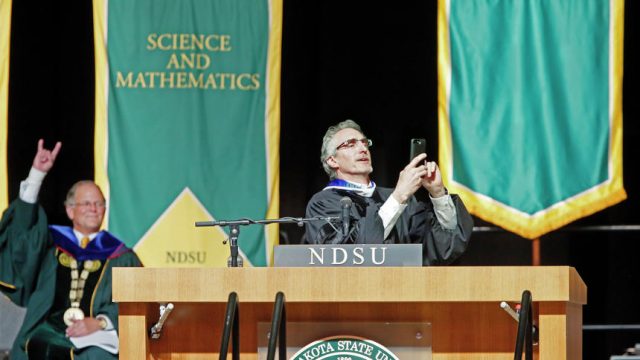Gov. Doug Burgum: Task Force Is About Governance Not Closing Campuses

North Dakota Governor Doug Burgum does a live Snapchat video as NDSU President Dean Bresciani flashes the Bison horns during the afternoon commencement address at graduation ceremonies from the Fargodome on Saturday, May 13, 2017. David Samson / The Forum
North Dakota is blessed with a robust higher education system. From students and faculty to administrators and alumni, our 11 public colleges and universities have enjoyed a broad base of support and tremendous investment appropriated by the state Legislature.
The system is strong, particularly for a state our size, and its enormous impact on our communities, graduates and economy is evident. Yet we must all recognize our system is being challenged by powerful economic forces enabled by rapid technological advancements, which in turn is driving competition through new education business models powered by massive, free, high-quality content; new delivery methods; lower-cost credentialing alternatives; changing cultural attitudes; rising student debt and more.
[mks_pullquote align=”right” width=”300″ size=”24″ bg_color=”#ffffff” txt_color=”#000000″]Creating such a system requires a governance structure that is nimble and empowers our educational leaders and faculty to make responsive decisions that enable our system to remain economically viable amid external forces transforming education across the world.[/mks_pullquote]
For North Dakota to reach its full potential, we need citizens equipped to compete in a global economy, which requires lifetime access to the best education at affordable prices. Creating such a system requires a governance structure that is nimble and empowers our educational leaders and faculty to make responsive decisions that enable our system to remain economically viable amid external forces transforming education across the world.
Our higher education system has experienced incredible growth and success over the past eight decades, yet our current governance model has remained largely unchanged since North Dakotans voted in 1938 to amend the state constitution to create a State Board of Higher Education, consisting of seven members appointed by the governor (an eighth member, representing students, was added in 1994).
With that in mind, I signed an executive order Tuesday, Nov. 7, creating the Task Force on Higher Education Governance.
Appointed by the governor, this 15-member Task Force will represent the interests of the students, faculty, business community and all branches of state government.
Specifically, the Task Force will:
- Identify best practices for higher education governance.
- Evaluate whether the current system operates at its highest potential to best serve the growing and changing educational and workforce needs in the 21st century.
- Recommend strategic governance improvements to the 2019 Legislature.
As I stated at Tuesday’s announcement, everything about higher education governance will be on the table as we engage in this critically important dialogue.
But let me be clear: The focus of this Task Force is on governance, not curriculum, teaching methods or campus footprints. It’s about identifying an optimal governance structure that allows our higher education system to be the most effective and efficient system it can be.
If you’d like to help shape the future of higher education governance in North Dakota, I encourage you to apply for the Task Force through the Boards and Commissions section at www.governor.nd.gov/boards by Nov. 30.
We have an opportunity in North Dakota to create the best K-12 and higher education systems in the world. But this will require us to adopt new thinking and new approaches. We must ensure the state’s investment in education allows us to not only keep up with our peers, but to lead the way as a model for the nation.




